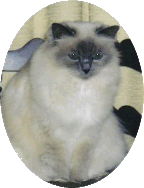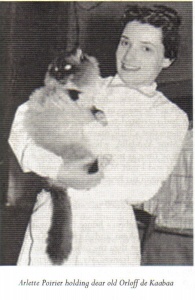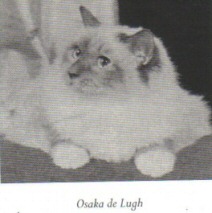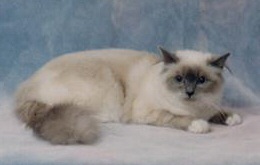
This is a little of the purebred Birman genealogy of Phelicity Marie Dauphine. Her proud human mom recently got her hands on a book from England that was translated from the French and had some pictures of her ancestors listed in her pedigree that we hadn't seen before. The Birman is one of the oldest natural breeds, originating in Burma (now Myanmar) and recorded in France in 1919. Our presentation here is just for friends, as the records concern Phelicity.

The beginnings of the Sacred Cat of Burma have much mystery and legend, but this much is known. In 1919, a pair of the sacred cats was sent to France from Burma. The male did not survive the trip, but the female, already pregnant, did. Her name was Sita. That same year, she gave birth to Poupee de Madalpour, according to records kept by early French breeders, which I was excited to confirm by finding Poupee in the Birman pedigree data base, as the mother of Fly de KaaBaa, born in Paris in 1928.

Orloff de KaaBaa, the grandson of Fly and son of Mickey de KaaBaa, was born in 1943. There is an earlier, unclear photo of Orloff at the end of WWII in Paris. This one was taken about 1952, with the daughter of Simone Poirier, whose interviews and records provided the book. At the end of the war, it's said there were only two breeding Birmans left alive in France, Orloff and Youla de KaaBaa, his grandmother. Orloff was bred back to her and later to his daughter Xenia, and thus was the Birman breed continued. Birmans had been shown in Paris from the time of the great International Cat Show of 1926 and the breed had spread to several European countries, but the war wiped out nearly all of them.

Hamlet de Madalpour, born in 1957, was the great-great-grandson of both Orloff deKaaBaa and Mickey de KaaBaa. Yes, among cats this is common. Phelicity's line comes through Hamlet, descended from Fly de KaaBaa and Poupee', as are all registered and purebred Birmans today, through Orloff and Xenia, from the de KaaBaas and the de Madalpours.

Phelicity's ancestors were still in France when the first Birmans began to arrive in America in 1960. One of the first of her direct line to be born here was Gertrude Griswold's Belyea Belle in 1963, the mother of Griswold's Boi Bleu. She was registered with the CFA in the US. I believe Boi Bleu was the first bluepoint of her line born here, in 1964.

On Boi Bleu's sire's side, Orlamonde de Khlaramour appears to be the first bluepoint born here, in 1965. She was the great-grandmother of Tibet Blue Rider, born in 1973, and Hamlet de Madalpour was the great-great-grandfather of Tibet. Tibet Blue Rider was the great-great-grandfather of Phelicity's sire.

Osaka de Lugh, a daughter of Hamlet de Madalpour, was a bluepoint Birman born in 1965, probably in France. A few years later her descendents and those of Griswold's Boi Bleu produced the first lilacpoint in Phelicity's line, Bonni-bir Yasmin, born in 1975 in Marie Bonneau's cattery in Des Moines. She was the mother of Phelicity's grandfather, the lilacpoint Bonni-bir Aramis, born in 1977. That same year, the CFA recognized the lilac and chocolate colors in Birmans, which was a result of breeding for diluting the natural colors, blue and seal, NOT a result of outcrossing to obtain "new" colors, such as red, that had never been in any Birman, but was started much later, to the detriment of the breed (in my opinion).
So Phelicity has lilac on her papa's side and a lot of blue from both sides. But her papa himself, Bonni-bir Dauphin of Wynsome-bir, was a sealpoint. So was her mother, Bar-bir-as Misha. I do so wish we had photos of them. The heavy blue genes came out and the entire litter that Phelicity was born into April 25, 1992, were bluepoints. Everyone was amazed.
Phelicity proved to be the best show-quality kitten in her litter. Her sister died in kittenhood from a dangerous flea product. One of her brothers showed well as a kitten but not as an adult. Her other brother was sold as pet-quality. I remember hearing, and still believe, that there were 5 kittens in that litter, but I don't know what may have happened to the 5th. In the Dallas-Ft. Worth matrix of connected Birman breeders, which I hoped to be part of, the hope for that litter was in Phelicity. She had great promise and seemed sure (as sure as these things in Birman breeding can be) to have lilacpoint kittens as well as blue.

She had a busy but short show season in 1993 as an adult, and fulfilled her promise in a Specialty show ring with her win as "Best Cat" over very stiff competition, including two Birman males who went on to great show careers. But three attempts to have her bred were unsuccessful and that was the limit I would put her and myself through. She was spayed and retired as a Champion at 17 months, and we'll never know what she might have produced. But it wasn't her destiny to produce the first Lilacpoint Supreme Grand Champion in that Region; she had an easier destiny with me to fulfill.
Her sire was Multi-Supreme Grand Champion Bonni-bir Dauphin of Wynsome-bir. He died in 1994 at the age of 14 in Ft. Worth, Texas. The Dauphine in her name is after him.
Her mother was a stunningly beautiful breeding queen named Misha, descended from the same wonderful ancestry. She died in 1998 at the age of 9 in Arlington, Texas.
Her sire and grandfather's breeder was Marie Bonneau, an admirable lady who did careful work to improve her line. She died in the late 1990's. The Marie in Phelicity's name is after her.
Phelicity is now 14 years old herself, and going strong. She came from the very best, and it shows. This Sept. 6th, 2006, was the 14th anniversary of the day she came into my life and changed it forever for the better.
Phelicity's Pedigree
|







